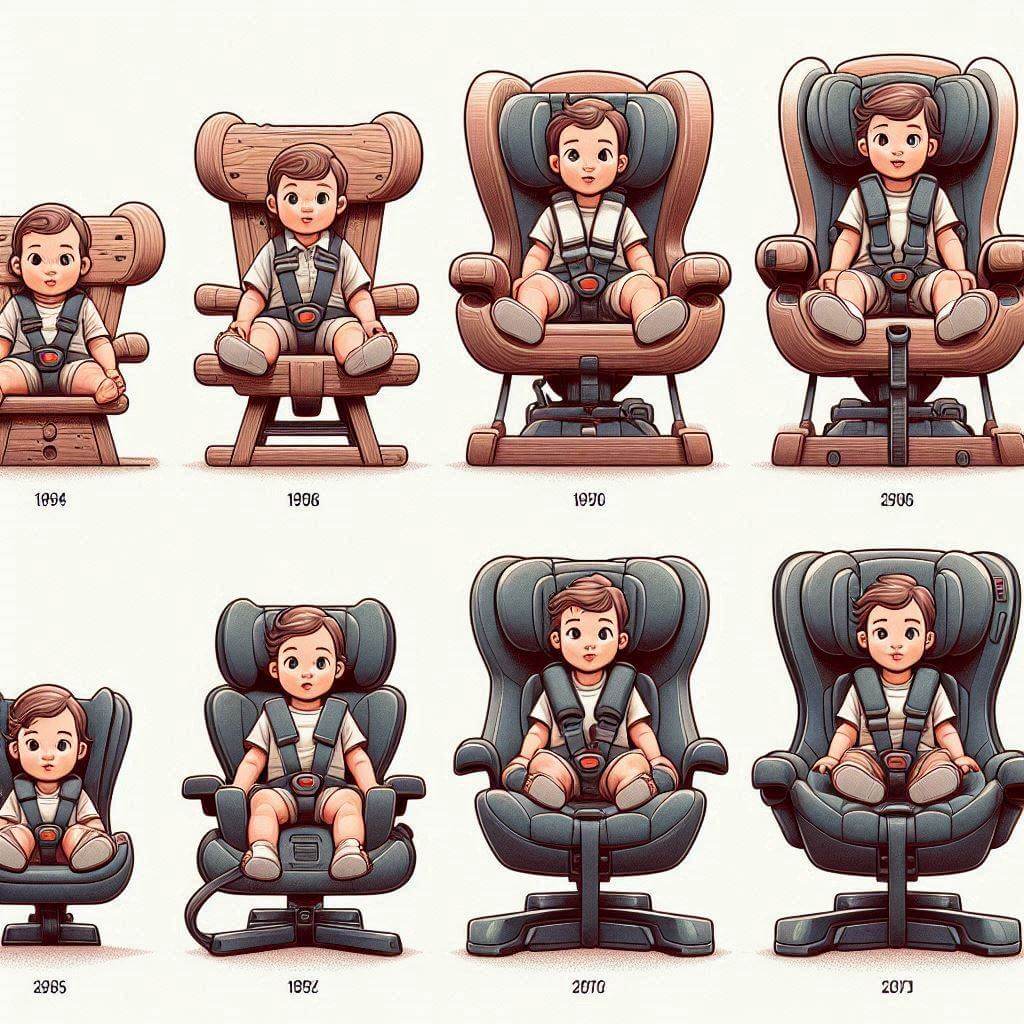The Evolution of Child Safety Seats: From Basic Protection to Advanced Safety Technology

Child safety seats have come a long way since their inception, evolving from simple restraints into sophisticated devices designed to protect young passengers with unparalleled precision. As automotive technology and safety standards have advanced, so too have the features and capabilities of child safety seats. This article explores the journey of child safety seats from their early beginnings to the latest innovations, highlighting how these developments have significantly improved child safety in vehicles.
Contents
The Early Days of Child Safety Seats
1. The Birth of the Car Seat: 1960s – 1970s
The concept of child safety seats began gaining traction in the 1960s and 1970s, driven by growing awareness of the need to protect young passengers in the event of a crash. Early models were rudimentary, often consisting of simple harnesses or cushions that lacked the advanced features we see today. These early designs were typically based on the idea of restraining a child in a vehicle, but they did not fully address the complexities of crash dynamics or offer comprehensive protection.
2. The Introduction of Standards: 1980s
The 1980s marked a significant turning point in the evolution of child safety seats. The introduction of safety standards and regulations, such as those established by the National Highway Traffic Safety Administration (NHTSA) in the United States, provided a framework for designing and testing child safety seats. These standards focused on improving the effectiveness of restraints, ensuring that seats met minimum safety requirements, and helping to reduce injuries in crashes.
Advances in Child Safety Seat Design
1. The Development of Rear-Facing Seats: 1990s
One of the most critical advancements in child safety seat design came with the increased emphasis on rear-facing seats. Research demonstrated that rear-facing seats provide superior protection for infants and toddlers, particularly during frontal collisions. The 1990s saw a shift in recommendations and regulations, with a growing recognition of the need to keep children in rear-facing seats for as long as possible. This change was driven by a better understanding of crash dynamics and the way infants’ bodies respond to impacts.
2. The Introduction of Convertible Seats: Late 1990s – 2000s
Convertible car seats, which can be used in both rear-facing and forward-facing configurations, became popular in the late 1990s and early 2000s. These seats offered greater versatility and extended the period during which children could be safely transported in the rear-facing position. Convertible seats also introduced features like adjustable harness systems and increased weight limits, accommodating growing children and enhancing overall safety.
3. Booster Seats and the Transition to Seat Belts: 2000s
As children outgrow convertible seats, booster seats became an essential part of the safety landscape. Booster seats elevate children so that the vehicle’s seat belt fits correctly across their chest and hips, providing better protection during a crash. The 2000s saw the introduction of high-back and backless booster seats, each offering different levels of support and comfort for children transitioning to using the vehicle’s seat belt alone.
Modern Innovations in Child Safety Seats
1. ISOFIX and LATCH Systems: 2000s – Present
The ISOFIX (International Standards Organisation FIX) and LATCH (Lower Anchors and Tethers for Children) systems represent significant innovations in child safety seat installation. These systems use standardized anchors and connectors to secure child safety seats more easily and securely than traditional seat belt installations. The introduction of ISOFIX and LATCH has reduced the likelihood of incorrect installations and improved the overall safety of child safety seats.
2. Advanced Harness Systems
Modern child safety seats come equipped with advanced harness systems designed to provide optimal protection and comfort. Features such as five-point harnesses, adjustable straps, and easy-to-use buckle systems ensure that children are securely restrained and that the harness fits correctly as they grow. Some seats also include no-rethread harnesses, allowing parents to adjust the harness height without rethreading, making it easier to adapt the seat to a growing child.
3. Side-Impact Protection
Side-impact protection has become a critical focus in modern child safety seats. Advances in design and materials have led to the development of seats with enhanced side-impact protection features, such as energy-absorbing foam, reinforced side wings, and adjustable headrests. These features help reduce the risk of injury during side collisions, providing additional safety for young passengers.
4. Crash-Test Simulation and Data-Driven Design
The use of advanced crash-test simulations and data-driven design has revolutionized the development of child safety seats. Manufacturers now use sophisticated computer models and crash-test dummies to simulate various crash scenarios and assess the performance of child safety seats. This data-driven approach allows for continuous improvement in design and safety features, ensuring that child safety seats provide the highest level of protection possible.
5. Smart Technology and Integration
The latest advancements in child safety seat technology include the integration of smart features and connectivity. Some modern seats are equipped with sensors that monitor the child’s position and provide real-time alerts if the seat is not properly installed or if the child’s harness is not secure. Additionally, some seats offer compatibility with smartphone apps, allowing parents to track and manage their child’s safety seat settings and performance.
The Role of Regulations and Safety Standards
1. Evolving Standards and Guidelines
Regulations and safety standards for child safety seats have evolved significantly over the years, driven by advancements in research and technology. Organizations such as the NHTSA, the European New Car Assessment Programme (Euro NCAP), and various national safety agencies continuously update their guidelines to reflect the latest research and best practices. These evolving standards ensure that child safety seats meet rigorous safety requirements and provide the best possible protection for young passengers.
2. Global Harmonization
Efforts to harmonize safety standards and regulations across different countries have led to greater consistency in child safety seat design and performance. International collaboration and the adoption of global standards, such as those established by the United Nations Economic Commission for Europe (UNECE), have helped create a unified approach to child safety seat regulations, benefiting parents and manufacturers worldwide.
The Future of Child Safety Seats
1. Innovations on the Horizon
The future of child safety seats promises even more advancements in technology and design. Emerging trends include the development of seats with enhanced crash-avoidance features, such as automatic recline adjustments during a collision and advanced impact-absorbing materials. Additionally, the integration of artificial intelligence and machine learning could lead to smart safety systems that adapt in real-time to changing conditions and potential hazards.
2. Focus on Ease of Use and Accessibility
As technology continues to advance, there will likely be a greater emphasis on making child safety seats easier to use and more accessible for all families. Innovations such as simplified installation processes, intuitive controls, and user-friendly interfaces will enhance the overall experience for parents and caregivers, ensuring that child safety seats are not only effective but also convenient and practical.
The evolution of child safety seats from basic protection to advanced safety technology represents a remarkable journey of innovation and progress. From the early days of simple restraints to the sophisticated, feature-rich seats of today, each advancement has contributed to enhancing the safety and well-being of young passengers. As technology continues to evolve, the future of child safety seats will bring even more improvements and innovations, further protecting our most precious passengers and ensuring their safety on the road. By understanding the history and advancements in child safety seat technology, parents and caregivers can make informed choices and continue to prioritize the safety of their children while traveling.


